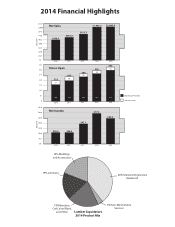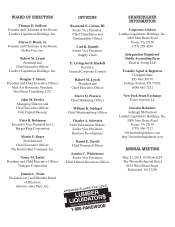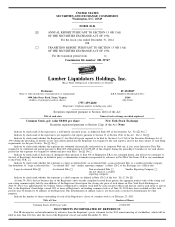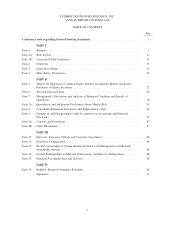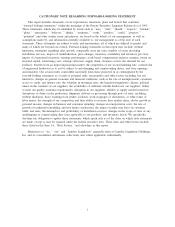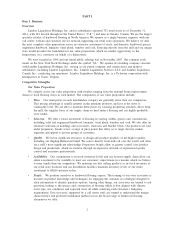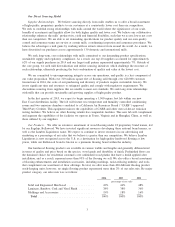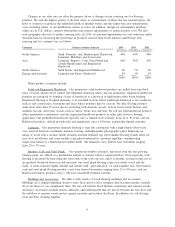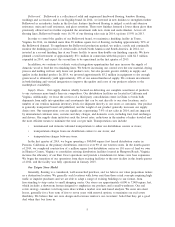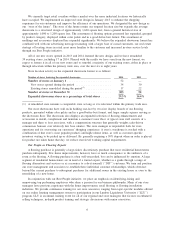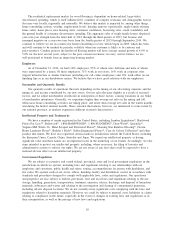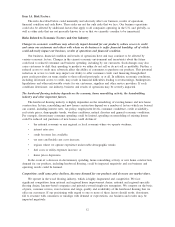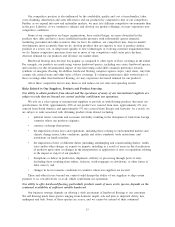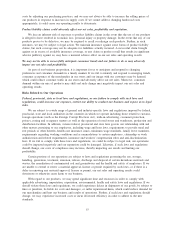Lumber Liquidators 2014 Annual Report Download - page 15
Download and view the complete annual report
Please find page 15 of the 2014 Lumber Liquidators annual report below. You can navigate through the pages in the report by either clicking on the pages listed below, or by using the keyword search tool below to find specific information within the annual report.We divide our U.S. stores into four primary geographic zones, each with a vice-president of sales, and
further segregate stores into regions with 10 to 15 stores overseen by a regional manager. Our hours of
operation are generally less than traditional retail and sales are less weighted to weekends. Combined with a
low number of associates supervised per location and average annual compensation of $80,000 to $90,000, we
believe our store manager position is valued in retail and our turnover is low compared to other retailers.
Sales Approach
We seek to appeal to customers who desire high-quality product at an attractive value. We sell our
products and services principally to existing homeowners who we believe represent over 90% of our customer
count. Most of our other sales are to contractors, who are primarily small businesses that are either building a
limited number of new homes or have been hired by a residential owner to put in a new floor.
Historically, our customers are in their mid-30’s or older, are well-educated and have income levels above
the average domestic household. We have found that homeowners prefer an assortment with a range of
characteristics, including appearance and durability, ease of installation and renewability of resources. Our
research indicates that our customers will choose to replace their flooring primarily after they have lived in
the home for a certain number of years, when a life event occurs such as a change in household members,
and/or prior to or shortly after moving into a new home. According to Catalina Research, Inc. (‘‘Catalina’’),
approximately 28% of buyers of an existing home undertake some type of flooring replacement project in the
first year of ownership.
Our primary focus has been on customers who are passionate about their flooring purchase and who often
define themselves as DIY. In recent years, we believe our value proposition has reached, and resonated with,
both the DIY customer and a customer considered more ‘‘casual.’’ The casual consumer generally has less
knowledge of the range of hard surface flooring products available or the purchase process itself, including
the key questions needed for the best flooring solution. In comparison to the DIY customer, this customer
generally requires a broader range of assistance from our sales associates and traditionally selects additional
services such as delivery and installation.
We compete for the DIY and more casual customers in a highly fragmented marketplace, where we
believe no one retailer has captured more than a 15% share of the market for hardwood flooring. We believe
the majority of the market consists of local one-store flooring retailers, small chains of stores that may
specialize in one or two flooring categories and a limited number of regional chains. While these independent
retailers once numbered over 13,000 and suffered during the downturn in residential home improvement,
Catalina estimates there are still approximately 9,000 specialty floor coverings stores. In order to react to local
market conditions, our store managers have certain limited flexibility in the price they can offer to each
customer, including the ability to offer a discount from an advertised price. We control this ‘‘ad-hoc’’
discounting through management reporting and daily follow-up, enhanced training of best practices and
limiting the range of discount that can be given by products. Where we believe no competitor has a
comparable product, we restrict all ad-hoc discounting.
We also compete against the national home improvement warehouse chains, including Home Depot
and Lowe’s, which together have over 4,000 store locations in the U.S. Catalina estimates that Lumber
Liquidators, Home Depot and Lowe’s combined represent approximately one-third of hardwood flooring
retail sales. We believe our product categories represent less than 2% of sales at an average Home Depot or
Lowe’s store.
Advertising
Advertising Reach and Frequency. Our advertising strategy includes a focus on broadening the reach
and frequency of our message to increase the recognition of our value proposition and ultimately the number
of customers served. We utilize a mix of traditional and new media, direct mail and financing offers to
emphasize product credibility, value, brand awareness, customer education and direct selling. We also utilize
local and national radio, primarily for promotional messaging. On the Internet, our advertising efforts include
the use of banner advertising, sponsoring links on well-known search engines, having storefronts with large
e-tailers and having a large network of online affiliate partners.
7


